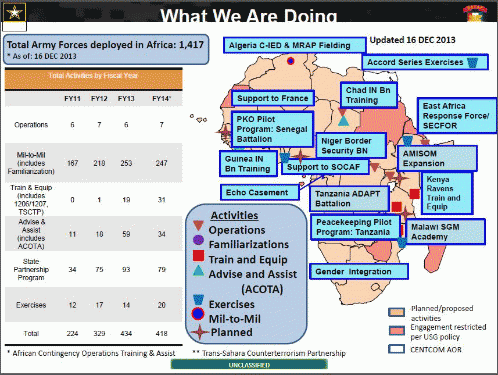U.S. Africa Command describes its activities as advancing "U.S. national security interests through focused, sustained engagement with partners" and insists that its "operations, exercises, and security cooperation assistance programs support U.S. Government foreign policy and do so primarily through military-to-military activities and assistance programs."
Saharan Express is a typical exercise that biennially pairs U.S. forces with members of the navies and coast guards of around a dozen mostly African countries. Operations include Juniper Micron and Echo Casemate, missions focused on aiding French and African interventions in Mali and the Central African Republic. Other "security cooperation" activities include the State Partnership Program, which teams African military forces with U.S. National Guard units and the State Department-funded Africa Contingency Operations Training and Assistance (ACOTA) program through which U.S. military mentors and advisors provide equipment and instruction to African units.
Many military-to-military activities and advisory missions are carried out by soldiers from the Army's 2nd Brigade Combat Team, 1st Infantry Division, as part of a "regionally aligned forces" effort that farms out specially trained U.S. troops to geographic combatant commands, like AFRICOM. Other training engagements are carried out by units from across the service branches, including Africa Partnership Station 13 whose U.S. naval personnel and Marines teach skills such as patrolling procedures and hand-to-hand combat techniques. Meanwhile, members of the Air Force recently provided assistance to Nigerian troops in areas ranging from logistics to airlift support to public affairs.
Click here to see a larger version
Previously undisclosed U.S. Army Africa records reveal a 94% increase in all activities by Army personnel from 2011 to 2013, including a 174% surge in State Partnership missions (from 34 to 93) and a 436% jump in Advise-and-Assist activities including ACOTA missions (from 11 to 59). Last year, according to a December 2013 document , these efforts involved everything from teaching Kenyan troops how to use Raven surveillance drones and helping Algerian forces field new mine-resistant ambush protected vehicles, or MRAPS, to training Chadian and Guinean infantrymen and aiding France's ongoing interventions in West and Central Africa.
AFRICOM spokesman Benjamin Benson refused to offer further details about these activities. "We do training with a lot of different countries in Africa," he told me. When I asked if he had a number on those "different countries," he replied, "No, I don't." He ignored repeated written requests for further information. But a cache of records detailing deployments by members of just the 2nd Brigade Combat Team, 1st Infantry Division, from June through December 2013, highlights the sheer size, scope, and sweep of U.S. training missions.
June saw members of the 2nd Brigade Combat Team deployed to Niger, Uganda, Ghana, and on two separate missions to Malawi; in July, troops from the team traveled to Burundi, Mauritania, Niger, Uganda, and South Africa; August deployments included the Democratic Republic of Congo, Kenya, South Africa, Niger, two missions in Malawi, and three to Uganda; September saw activities in Chad, Togo, Cameroon, Ghana, São Tomé and Prncipe, Sierra Leone, Guinea, Uganda, and Malawi; in October, members of the unit headed for Guinea and South Africa; November's deployments consisted of Lesotho, Ethiopia, Tanzania, Uganda, and Guinea; while December's schedule consisted of activities in South Sudan, Cameroon, and Uganda, according to the documents. All told, the 2nd Brigade Combat Team, 1st Infantry Division carried out 128 separate "activities" in 28 African countries during all of 2013.
The records obtained by TomDispatch also indicate that U.S. Army Africa took part in almost 80% of all AFRICOM activities on the continent in 2013, averaging more than one mission per day. Preliminary projections for 2014 suggest a similar pace this year -- 418 activities were already planned out by mid-December 2013 -- including anticipated increases in the number of operations and train-and-equip missions.
Full-scale exercises, each involving U.S. Army troops and members of the militaries of multiple African countries, are also slated to rise from 14 to 20 in 2014, according to the documents. So far, AFRICOM has released information on 11 named exercises scheduled for this year. These include African Lion in Morocco, Eastern Accord in Uganda, Western Accord in Senegal, Central Accord in Cameroon, and Southern Accord in Malawi, all of which include a field training component and serve as a capstone event for the prior year's military-to-military programs. AFRICOM will also conduct at least three maritime security exercises, including Cutlass Express off the coast of East Africa, Obangame Express in the Gulf of Guinea, and Saharan Express in the waters off Senegal and the Cape Verde islands, as well as its annual Africa Endeavor exercise, which is designed to promote "information sharing" and facilitate standardized communications procedures within African militaries.
Additionally, U.S. and African Special Operations forces will carry out an exercise codenamed Silent Warrior 2014 in Germany and have already completed Flintlock 2014 (since 2005, an annual event). As part of Flintlock 2014, more than 1,000 troops from 18 nations, including Burkina Faso, Canada, Chad, Denmark, France, Germany, Italy, Mauritania, the Netherlands, Nigeria, Norway, Senegal, the United Kingdom, the U.S., and the host nation of Niger, carried out counterterror training on the outskirts of Niamey, the capital, as well as at small bases in Tahoua, Agadez, and Diffa. "Although Flintlock is considered an exercise, it is really an extension of ongoing training, engagement, and operations that help prepare our close Africa partners in the fight against extremism and the enemies that threaten peace, stability, and regional security," said Colonel Kenneth Sipperly, the commander of the U.S. Joint Special Operations Task Force-Trans Sahel, during the Flintlock opening ceremony.
Locations, Locations, Locations
A 2013 investigation by TomDispatch analyzing official documents and open source information revealed that the U.S. military was involved with at least 49 of the 54 nations on the African continent during 2012 and 2013 in activities that ranged from special ops raids to the training of proxy forces. A map produced late last year by U.S. Army Africa bolsters the findings, indicating its troops had conducted or planned to conduct "activities" in all African "countries" during the 2013 fiscal year except for Western Sahara (a disputed territory in the Maghreb region of North Africa), Guinea Bissau, Eritrea, Sudan, Somalia, São Tomé and Prncipe, Madagascar, and Zimbabwe. Egypt is considered outside of AFRICOM's area of operations, but did see U.S. military activity in 2013, as did Somalia, which now also hosts a small team of U.S. advisors. Other documents indicate Army troops actually deployed to São Tomé and Prncipe, a country that regularly conducts activities with the U.S. Navy.
AFRICOM is adamant that the U.S. military has only one base on the continent: Camp Lemonnier in Djibouti. Official documents examined by TomDispatch, however, make reference to bases by other names: forward operating sites, or FOSes (long-term locations); cooperative security locations, or CSLs (through which small numbers of U.S. troops periodically rotate); and contingency locations, or CLs (which are used only during ongoing missions).
AFRICOM has repeatedly denied requests by TomDispatch for further information on the numbers or locations of FOSes, CSLs, and CLs, but official documents produced in 2012 make reference to seven cooperative security locations, including one in Entebbe, Uganda, a location from which U.S. contractors have flown secret surveillance missions, according to an investigation by the Washington Post. Information released earlier this year by the military also makes references to at least nine "forward operating locations," or FOLs in Africa.
We Know Not What They Do
"What We Are Doing," the title of a December 2013 military document obtained by TomDispatch, offers answers to questions that AFRICOM has long sought to avoid and provides information the command has worked to keep under wraps. So much else, however, remains in the shadows.
(Note: You can view every article as one long page if you sign up as an Advocate Member, or higher).






